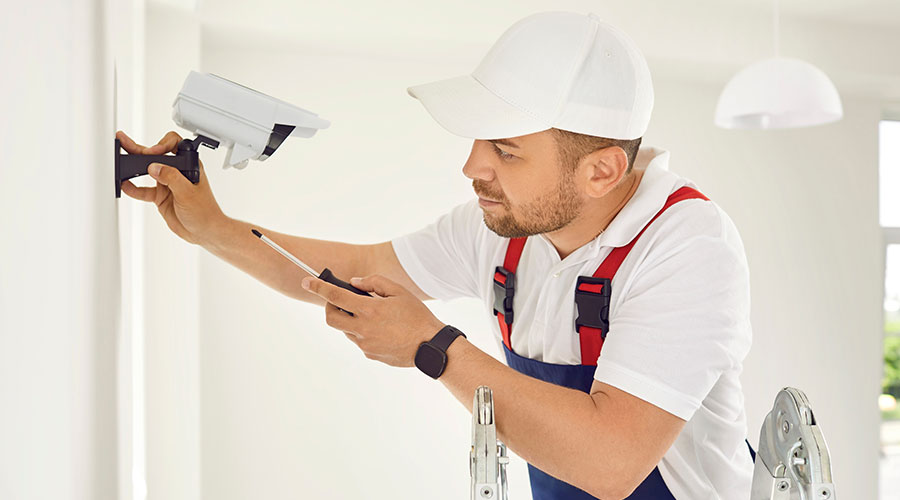Using Smart Building Strategies to Meet Energy, Sustainability Goals
Executive summary: Many organizations are taking steps to make buildings more energy efficient and more sustainable. At the same time, many are implementing smart building measures. The results of a new survey of facility executives demonstrates that smart building measures are being used to improve energy and sustainability performance, and that those measures have in fact proven to boost performance in those areas. But a more strategic approach to smart buildings, combined with even wider use of smart building measures, represents an important opportunity for facility executives to drive further gains in energy efficiency and sustainability.
This white paper examines facility executives' experiences with smart buildings and shows how smart building measures can enable other key organizational goals.
Topics addressed include:
- Synergies between smart buildings, energy efficiency, and sustainability
- Facility executives' plans for smart building upgrades
- Value of a broad-based team to develop smart building strategies
- Role of people in smart building strategies
- Integration as a key to a smart building strategy
It's a rare facility executive who doesn't devote significant effort to improving energy efficiency or sustainability. These two issues are now priorities for many organizations. Increasingly, organizations are also seeing the benefits of implementing measures to make their buildings smarter. And as those smart building strategies have been implemented, experience has shown they are key enablers for meeting energy efficiency and sustainability goals.
The synergy among sustainability, energy efficiency, and smart building strategies suggests facility executives should address all three in combination, rather than each separately. For example, smart building strategies can help facility executives ensure good indoor environmental quality leading to occupant comfort, a key sustainability goal, while hitting energy efficiency targets. Indeed, smart building strategies should be seen as key ways to achieve energy efficiency and sustainability goals.
Today, however, the fact is many organizations have failed to take advantage of key smart building opportunities that can not only improve operational efficiency, but also reduce energy costs and buttress sustainability efforts. Many organizations have also failed to link smart building strategies with strategies for energy efficiency and sustainability. But the next few years should see a significant increase in the implementation of important smart building measures.
These are among the key findings of a survey of facility executives conducted by Siemens Industry, Inc., and Building Operating Management magazine, as well as discussions with facility executives and other experts in the field. That research points the way to the wider use of smart building technology to help achieve energy efficiency and sustainability objectives.
Smart Building Strategy Defined
Although there is no single, universally accepted definition of a smart building, widespread agreement exists about some of the key elements of the concept. A key part of the consensus is that smart building strategies improve the productivity of people and processes in buildings and lead to better decisions, based on actionable information, for improvements to the facility.
Technology is also critical. For example, smart buildings tap building automation systems (BAS), allowing facility executives to have the building's core systems seamlessly integrated. And smart buildings often leverage advanced technology to make their properties as efficient and sustainable as possible.
A smart building strategy "works to ensure that a building can provide timely, integrated systems information to building owners, managers, and tenants so that they can make intelligent decisions regarding operations and maintenance," explains Ronald J. Zimmer, president and CEO of the Continental Automated Buildings Association (CABA). This plan "evolves with changing user requirements and technology, ensuring continued and improved optimization," Zimmer says.
Smart buildings are comfortable buildings for occupants. "Ideally, such a strategy leads to a building that uses both technology and process to create a facility that is safe, healthy, and comfortable and enables productivity and well-being for its occupants," says Zimmer.
Tom Shircliff, co-founder of Intelligent Buildings, LLC, a real estate professional services company, points out that "strategy is about what is happening to you and what to do about it." And what Shircliff sees happening involves material changes in building controls technology. Given that perspective, he says there should be three basic outcomes to a smart building strategy:
"1. The Hippocratic Oath: 'First, do no harm' when spending capital and operational budget money by avoiding proprietary solutions and disconnected building systems.
"2. Lower Cost Structure: Create a base strategy that lowers your overall and ongoing capital and operational cost structure. This aligns all planned projects and spending with a smart building strategy.
"3. Data-Driven Decisions: Move your organization to a data-driven decision making culture. Big data and the cloud have finally come to real estate, and there are millions of data points that can provide insights, risk reduction, and lower costs."
Improving and Enabling
According to the Siemens/Building Operating Management survey, many organizations are taking steps to make their buildings smarter, more energy efficient, and more sustainable. (See Figure 1.)
Figure 1. Which of the following improvement measures has your organization taken in the past three years? R=821
Water efficiency measures
Integration for building systems
Automated monitoring and reporting
Retrocommissioning of building systems
Automated fault detection & diagnostics
The top two items on the list are measures that often have a very rapid payback or are very low cost — not surprising, given the economic conditions of the past three years. But the survey indicates smart building elements have been under-deployed in comparison to how important facility executives say those elements are.
The survey asked whether a range of measures were important for achieving energy and sustainability goals. Sixty nine percent of respondents say "integration for building systems" is an important smart building strategy to meet energy and sustainability goals, yet only 39 percent of respondents report having implemented integration in the past three years. Similarly, 52 percent say "automated monitoring and reporting" is important, yet only 37 percent report having implemented it. A similar situation holds for "automated fault detection and diagnostics" (31 percent say it's important but only 14 percent implemented it), "automated optimization" (30 percent vs. 15 percent) "continuous commissioning" (24 percent vs. 10 percent), and "dashboards" (21 percent vs. 12 percent).
One exception to this pattern: 54 percent of respondents call controls upgrades important and 47 percent say they performed controls upgrades in the past three years.
Obstacles to Smart Building Strategies
Facility executives say that money often is the biggest obstacle to smart building strategies. Tom Walsh, chief engineer for Transwestern Commercial Services, stresses this includes not just first cost, but also return on investment (ROI). "We prefer ROIs in two to three years," Walsh explains. He also looks for energy improvements that will increase the value of the building.
The survey results bear out the extent to which a lack of financial resources can be an obstacle to smart building strategies. While only 3 percent of respondents say smart building technology is not available today, 69 percent say they don't have a budget for smart building strategies. What's more, having staff resources — another budget issue — is an obstacle for roughly half of respondents. (See Figure 2)
Figure 2. What are the obstacles to development and
implementation of smart building strategies in your organization? R=469
We don't have a budget for smart building strategies
We don't have time/staff to implement smart building strategies
Smart building strategies cost too much
I'm not familiar with smart building strategies
Top management does not support the use of smart building strategies
Information about smart building technology is not readily available
Smart building technology is not available today
Thomas F. Smyth, director, facility services at Cobbleskill Regional Hospital, also believes another obstacle is education and training. "How much quality training is available from the company that sold you that system?" Smyth asks. "Sometimes the training is free. Sometimes training is so expensive you cannot afford it." On the topic of training, Smyth also believes refresher courses are valuable both for existing facilities staff and for new hires.
Kristina Moores, an associate at Arup, an engineering and design firm, thinks the biggest obstacle to smart building strategies is not all building systems are tied into the building management system, followed closely by the lack of user education. "There are many vendors selling smart equipment and programs, but the new software may not allow for coordinated systems and points reporting from existing building systems," Moores points out.
Experience With Smart Building Systems
Although funding has posed a hurdle to wider implementation of smart building measures, the survey shows that those measures have paid off with gains in energy efficiency and sustainability. Among facility executives who have implemented smart building strategies, a large majority has found that those measures aid efforts to boost energy efficiency and sustainability. (See Figures 3 and 4.)
Figure 3. Have steps you've taken to make your facilities smarter also improved energy efficiency outcomes? R=826
Haven't taken steps to make the facility smarter
Figure 4. Have steps you've taken to make your facilities smarter also improved sustainability outcomes? R=830
Haven't taken steps to make the facility smarter
It's worth noting that fairly significant numbers of facility executives say their organizations haven't taken steps to make the facility smarter. When those organizations are factored out, the vote for the value of smart building measures is even stronger. Looking strictly at respondents who have taken smart building measures, 96 percent say those steps improved energy efficiency, and 86 percent say they improved sustainability.
These results are in line with the experiences of those who are familiar with smart building strategies. Facility executives and independent experts alike have seen that smart building strategies can improve building performance, increasing overall energy efficiency and assisting in sustainability efforts. In addition, the savings in energy costs can improve the bottom line.
According to CABA statistics, advanced smart building strategies can reduce energy use as much as 50 percent compared to unimproved buildings, "with the most efficient buildings performing up to 70 percent better than conventional properties," says Zimmer.
With smart building strategies, energy efficiency isn't achieved at the expense of occupant comfort. "If you put the effort and brainpower into your BAS, you can get what you are looking for in controlling the comfort level and also keeping a handle on the energy side of things," says Smyth.
Provided senior management buys into the smart building strategy, implementation and execution are thought out, and accountability exists, "smart building strategies can significantly lower operational costs through optimizing building functionality across different systems such as lighting, HVAC, security, elevators, etc.," says Rob Murchison, co-founder of Intelligent Buildings, LLC. Murchison also points to the importance of retrocommissioning and continuously commissioning the building, as well as monitoring and measuring progress.
Key strategies that enable energy efficiency and sustainability ideally use BAS and building energy management systems from building inception, suggests Zimmer. On-going commissioning also is critical. "Through the use of these technologies and techniques, building owners and managers can realize many financial benefits, including lower energy costs, lower maintenance costs, and lower repair and replacement costs," he explains.
It's important for facility executives to present a complete picture of the economic value of smart building measures when seeking funding. "Building managers can use life-cycle costs analysis to calculate the cost of a building system over its entire life span," notes Zimmer. The life cycle process analyzes the long-term impact of construction and infrastructure costs on forecasted operational costs throughout the expected life of the property.
Medical Center Uses BAS for Smart Energy, Sustainability Strategies
 Located in central Texas, Dell Children's Medical Center is part of the Seton Family of Hospitals. The 503,000-square-foot medical center has achieved LEED Platinum certification for new construction.
Located in central Texas, Dell Children's Medical Center is part of the Seton Family of Hospitals. The 503,000-square-foot medical center has achieved LEED Platinum certification for new construction.
Acting as the heart of this accomplishment is a building
automation system (BAS) that efficiently integrates
numerous facility systems and devices. From a single
workstation, technicians can monitor and control indoor air
quality, HVAC operation, and utility distribution. An energy
management system also integrates the fire alarm system
and provides air handling system control.
Alan Bell, Seton's director of design and construction, reports
that "with our building system we've been able to achieve
about 17 percent better efficiency than ASHRAE standards,
which was the target for our LEED rating."
The medical center's BAS supports complex smart building strategies for energy conservation and sustainability. For example, integration with variable frequency drives in combination with underfloor systems drives energy costs down. In addition, chilled water consumption is monitored, kilowatt-hour use is calculated, and run time on all pumps is managed by the BAS.
Related Topics:










 Located in central Texas, Dell Children's Medical Center is part of the Seton Family of Hospitals. The 503,000-square-foot medical center has achieved LEED Platinum certification for new construction.
Located in central Texas, Dell Children's Medical Center is part of the Seton Family of Hospitals. The 503,000-square-foot medical center has achieved LEED Platinum certification for new construction.

